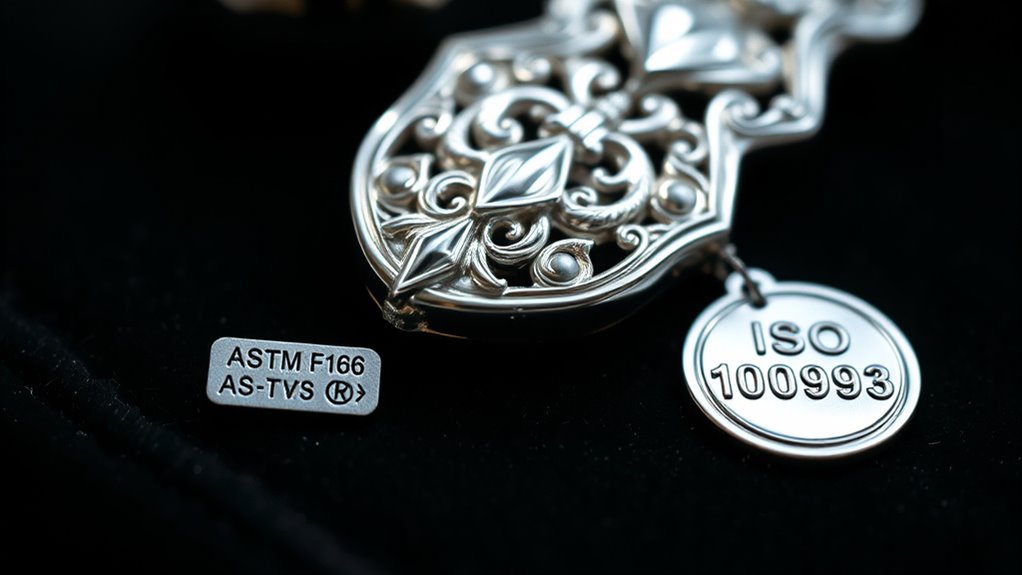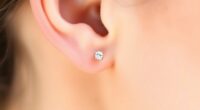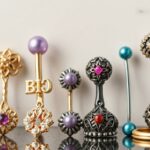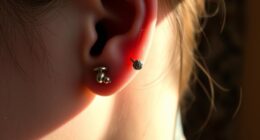Jewelry certifications like ASTM F136 and ISO 10993 verify that the materials used are safe, authentic, and meet strict industry standards. ASTM F136 ensures that titanium is biocompatible and safe for prolonged skin contact, while ISO 10993 confirms the biocompatibility of various materials. These certifications help protect you from counterfeits and substandard pieces, giving you confidence in your purchase. Keep exploring to learn more about how these standards guarantee jewelry safety and authenticity.
Key Takeaways
- Jewelry certifications verify the authenticity, quality, and safety of materials like metals and gemstones.
- ASTM F136 certifies implant-grade titanium as biocompatible and safe for prolonged skin contact.
- ISO 10993 assesses biocompatibility of materials to ensure they do not cause health issues or allergic reactions.
- Certifications provide official documentation to confirm jewelry meets safety standards and authenticity.
- Having proper certification helps in resale, insurance claims, and protects consumers from counterfeit products.
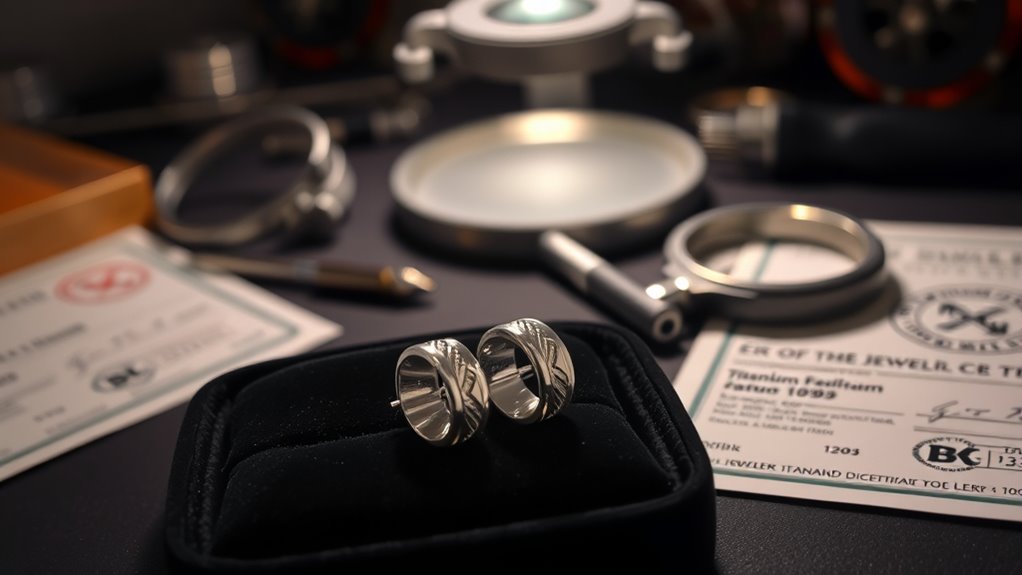
Have you ever wondered how to guarantee your jewelry is authentic and of high quality? One of the most reliable ways is by understanding jewelry certifications. These certifications are official attestations that confirm the jewelry meets specific standards, especially when it comes to material safety and quality. When you’re shopping for jewelry, especially pieces made from precious metals or containing gemstones, certification standards help ensure you’re getting what you pay for and that the piece is safe to wear. Certifications like ASTM F136 and ISO 10993 are designed to address these concerns, providing you with peace of mind about the safety and authenticity of your jewelry.
Material safety is a key aspect that certification standards cover. For example, ASTM F136 pertains to implant-grade titanium, ensuring that the metal used in jewelry is biocompatible and free from harmful substances. This certification guarantees that the titanium is safe for prolonged contact with skin, reducing risks of allergic reactions or skin irritation. Similarly, ISO 10993 is a set of international standards focusing on the biocompatibility of materials used in medical devices, but it’s also relevant to jewelry, especially for items like body piercings or jewelry worn for extended periods. It verifies that the materials used are safe and unlikely to cause adverse health effects. By choosing jewelry backed by these standards, you minimize the risk of allergic reactions, skin discoloration, or other health issues stemming from unsafe materials.
Certification standards like ASTM F136 and ISO 10993 ensure jewelry safety and biocompatibility for prolonged skin contact.
Certification standards also serve as a mark of authenticity. For instance, a certification from a recognized authority tells you that the jewelry has been tested and verified against rigorous criteria. This is particularly important for high-value items like diamond engagement rings or vintage jewelry, where the authenticity of gemstones and metals can be difficult to assess without proper documentation. Certifications often include details about the origin, quality, and purity of the materials, giving you confidence that you’re investing in genuine pieces. Moreover, reputable certifications can protect you from counterfeit or substandard jewelry, which is increasingly common in the marketplace.
In addition, proper documentation from certification authorities can facilitate resale or insurance claims, adding another layer of security to your purchase. In essence, certification standards are your safeguard in the jewelry world. They ensure material safety by confirming that the metals and stones used meet strict health and safety guidelines. They also verify authenticity, helping you make informed decisions and avoid scams. When you see a certification label or certificate accompanying a piece of jewelry, you can trust that it’s been evaluated for quality and safety. So, next time you’re buying jewelry, look for these certifications—they’re your best assurance that your jewelry is both beautiful and safe to wear.
Frequently Asked Questions
How Do Certifications Impact Jewelry Pricing and Value?
Certification influence considerably impacts jewelry pricing and value by enhancing market perception of quality and safety. When you see certified jewelry, you’re more confident in its authenticity and craftsmanship, which justifies a higher price. Certifications act as a mark of trust, attracting buyers who prioritize safety and standards. As a result, certified jewelry often commands better resale value and customer loyalty, making certifications a key factor in overall market perception and perceived worth.
Can Uncertified Jewelry Still Be Safe to Wear?
Like Pandora’s box, uncertified jewelry might seem safe, but without proper certification, you can’t be sure about material safety. The certification process verifies that jewelry meets strict safety standards, reducing risks of allergic reactions or toxic exposure. While some uncertified pieces may be safe, there’s no guarantee. To protect yourself, choose jewelry with recognized certifications, ensuring you wear items tested and proven safe for your skin and health.
Are Certifications Like ASTM F136 Required by Law?
You might wonder if certifications like ASTM F136 are legally mandated. Generally, legal requirements for jewelry certification standards vary by location. In some regions, certain standards help ensure safety but aren’t mandated by law, while others may require specific certifications for selling jewelry, especially for items like piercings. It’s essential to verify your local regulations because compliance with certification standards can help protect consumers and avoid legal issues.
How Often Should Jewelry Certifications Be Renewed or Updated?
You should verify the certification renewal requirements for each jewelry certification, as they vary by organization. Typically, certifications have an expiration date, and you need to renew them before this date to remain compliant. Keep track of the expiration date and plan ahead to renew your certification on time. Regular updates ensure your jewelry continues to meet safety standards and maintains market credibility.
What Should I Do if My Jewelry’S Certification Is Expired?
An expired certification might seem like a setback, but it’s a chance to guarantee your jewelry’s safety. You should contact the certifying authority for a certification renewal or consider a repair process if needed. Continuing to wear or sell uncertified jewelry poses risks. Prioritize obtaining up-to-date documentation to maintain trust and compliance, safeguarding your health and reputation. Stay proactive by renewing certifications promptly to keep your jewelry’s quality assured.
Conclusion
Now that you understand key jewelry certifications like ASTM F136 and ISO 10993, you can shop with confidence. Think of these standards as your guiding stars, leading you to safe and quality jewelry. Remember, knowledge is power, and it’s better to be safe than sorry when it comes to precious accessories. So, keep your eyes open and don’t let the details slip through the cracks—your perfect piece is worth the extra look.
I’m Gillian. I love piercings and tattoos- there’s something about the way they make your body look that just makes me happy. I started this blog to share my passion for piercings and tattoos with the world and to help people who are thinking of getting their first piercing or tattoo.
I’ve been writing about piercings and tattoos for a while now on piercings-body.com. I love sharing my knowledge with others and helping people make informed decisions about their bodies.

